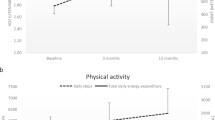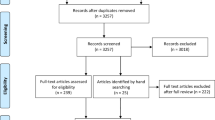Abstract
Study design
Longitudinal cohort study.
Objectives
Examine the longitudinal association between mobility and level of physical activity (PA) and explore which other factors are also associated with level of PA in ambulatory people with Spinal Cord Injury (SCI) during the first-year post-inpatient rehabilitation.
Setting
Three SCI-specialized rehabilitation centers and the Dutch community.
Methods
Forty-seven adults with recent SCI and ambulatory function were included. All had motor incomplete lesions, 49% had tetraplegia, and the mean age was 55 ± 13 years. Duration of accelerometry-based all-day PA and self-reported level of mobility, exertion of walking, pain, fatigue, depressive mood symptoms, fear of falling, exercise self-efficacy, and attitude toward PA were measured just before discharge from inpatient rehabilitation and 6 and 12 months after discharge. All data were longitudinally analyzed using generalized estimating equations analyses. Models were corrected for age, lesion level, and time since injury.
Results
Mobility was longitudinally associated with level of PA (beta: 4.5, P < 0.001, R2: 41%). In addition, lower levels of exertion of walking (beta: −5.6, P < 0.001), fear of falling (beta: −34.1, P < 0.001), and higher levels of exercise self-efficacy (beta: 2.3, P = 0.038) were associated with higher levels of PA. Exertion of walking and fear of falling were associated with level of PA independent of mobility.
Conclusions
Mobility, exertion of walking, fear of falling, and exercise self-efficacy seem to be correlates of level of PA in ambulatory people with SCI during the first year after inpatient rehabilitation. Targeting these factors using an interdisciplinary approach may enhance levels of PA in this population.
This is a preview of subscription content, access via your institution
Access options
Subscribe to this journal
Receive 12 print issues and online access
$259.00 per year
only $21.58 per issue
Buy this article
- Purchase on Springer Link
- Instant access to full article PDF
Prices may be subject to local taxes which are calculated during checkout

Similar content being viewed by others
Data availability
The datasets generated during and/or analyzed during the current study are available from the corresponding author on reasonable request.
References
Das P, Horton R. Physical activity-time to take it seriously and regularly. Lancet. 2016;388:1254–5.
van den Berg-Emons RJ, Bussmann JB, Stam HJ. Accelerometry-based activity spectrum in persons with chronic physical conditions. Arch Phys Med Rehabil. 2010;91:1856–61.
Rezende LS, Lima MB, Salvador EP. Interventions for Promoting Physical Activity Among Individuals With Spinal Cord Injury: A Systematic Review. J Phys Act Health. 2018;15:954–9.
Nooijen CF, Stam HJ, Bergen MP, Bongers-Janssen HM, Valent L, van Langeveld S, et al. A behavioural intervention increases physical activity in people with subacute spinal cord injury: a randomised trial. J Physiother. 2016;62:35–41.
van der Scheer JW, Martin Ginis KA, Ditor DS, Goosey-Tolfrey VL, Hicks AL, West CR, et al. Effects of exercise on fitness and health of adults with spinal cord injury: A systematic review. Neurology. 2017;89:736–45.
Saraf P, Rafferty MR, Moore JL, Kahn JH, Hendron K, Leech K, et al. Daily stepping in individuals with motor incomplete spinal cord injury. Phys Ther. 2010;90:224–35.
Ginis KA, Latimer AE, Arbour-Nicitopoulos KP, Buchholz AC, Bray SR, Craven BC, et al. Leisure time physical activity in a population-based sample of people with spinal cord injury part I: demographic and injury-related correlates. Arch Phys Med Rehabil. 2010;91:722–8.
Postma K, Bussmann JBJ, van Diemen T, Post MWM, Dekkers J, van Nes IJW, et al. Physical Activity and Sedentary Behavior From Discharge to 1 Year After Inpatient Rehabilitation in Ambulatory People With Spinal Cord Injury: A Longitudinal Cohort Study. Arch Phys Med Rehabil. 2020;101:2061–70.
Lawrason SVC, Todd KR, Shaw RB, Martin Ginis KA. Physical activity among individuals with spinal cord injury who ambulate: a systematic scoping review. Spinal Cord. 2020;58:735–45.
van der Ploeg HP, van der Beek AJ, van der Woude LH, van Mechelen W. Physical activity for people with a disability: a conceptual model. Sports Med. 2004;34:639–49.
Martin Ginis KA, Papathomas A, Perrier MJ, Smith B, Group S-SR. Psychosocial factors associated with physical activity in ambulatory and manual wheelchair users with spinal cord injury: a mixed-methods study. Disabil Rehabil. 2017;39:187–92.
van Diemen T, Scholten EW, van Nes IJ, Group S-S, Geertzen JH, Post MW. Self-Management and Self-Efficacy in Patients With Acute Spinal Cord Injuries: Protocol for a Longitudinal Cohort Study. JMIR Res Protoc. 2018;7:e68.
Horemans H, Kooijmans H, van den Berg-Emons R, Bussmann H. The Activ8 activity monitor: Validation of posture and movement classification. J Rehabil Assist Technol Eng. 2020;7:2055668319890535.
Claridge EA, van den Berg-Emons RJG, Horemans HLD, van der Slot WMA, van der Stam N, Tang A, et al. Detection of body postures and movements in ambulatory adults with cerebral palsy: a novel and valid measure of physical behaviour. J Neuroeng Rehabil. 2019;16:125.
Postma K, Latour T, Van den Berg-Emons HJG, Horemans HLD, Bussmann H. Valid detection of wheelchair driving in addition to regular posture and motion detection. ICAMPAM. Bethesda, Maryland USA2017.
Fekete C, Eriks-Hoogland I, Baumberger M, Catz A, Itzkovich M, Luthi H, et al. Development and validation of a self-report version of the Spinal Cord Independence Measure (SCIM III). Spinal Cord. 2013;51:40–7.
Lampropoulou S, Nowicky AV. Evaluation of the numeric rating scale for perception of effort during isometric elbow flexion exercise. Eur J Appl Physiol. 2012;112:1167–75.
Jensen MP, Karoly P. Self-report scales and procedures for assessing pain in adults. In: Turk DCaM, R, editor. Handbook of pain assessment. 3rd ed. New York, NY: Guilford Press; 2001. p. 15–34.
Anton HA, Miller WC, Townson AF. Measuring fatigue in persons with spinal cord injury. Arch Phys Med Rehabil. 2008;89:538–42.
Zigmond AS, Snaith RP. The hospital anxiety and depression scale. Acta Psychiatr Scand. 1983;67:361–70.
Sakakibara BM, Miller WC, Orenczuk SG, Wolfe DL, Team SR. A systematic review of depression and anxiety measures used with individuals with spinal cord injury. Spinal Cord. 2009;47:841–51.
Kempen GI, Yardley L, van Haastregt JC, Zijlstra GA, Beyer N, Hauer K, et al. The Short FES-I: a shortened version of the falls efficacy scale-international to assess fear of falling. Age Ageing. 2008;37:45–50.
Jonasson SB, Nilsson MH, Lexell J. Psychometric properties of the original and short versions of the Falls Efficacy Scale-International (FES-I) in people with Parkinson’s disease. Health Qual Life Outcomes. 2017;15:116.
Nooijen CF, Post MW, Spijkerman DC, Bergen MP, Stam HJ, van den Berg-Emons RJ. Exercise self-efficacy in persons with spinal cord injury: psychometric properties of the Dutch translation of the Exercise Self-Efficacy Scale. J Rehabil Med. 2013;45:347–50.
Latimer AE, Ginis KAM. The theory of planned behavior in prediction of leisure time physical activity among individuals with spinal cord injury. Rehabilitation Psychology. 2005;50:389–96.
Twisk JW. Applied longitudinal data analysis for epidemiology: a practical guide. Cambridge, UK: Cambridge University Press; 2003.
Guralnik JM, Kritchevsky SB. Translating research to promote healthy aging: the complementary role of longitudinal studies and clinical trials. J Am Geriatr Soc. 2010;58:S337–42.
Matthews CE, Keadle SK, Troiano RP, Kahle L, Koster A, Brychta R, et al. Accelerometer-measured dose-response for physical activity, sedentary time, and mortality in US adults. Am J Clin Nutr. 2016;104:1424–32.
Hornby TG, Reisman DS, Ward IG, Scheets PL, Miller A, Haddad D, et al. Clinical Practice Guideline to Improve Locomotor Function Following Chronic Stroke, Incomplete Spinal Cord Injury, and Brain Injury. J Neurol Phys Ther. 2020;44:49–100.
Rauch A, Hinrichs T, Cieza A. Associations with being physically active and the achievement of WHO recommendations on physical activity in people with spinal cord injury. Spinal Cord. 2017;55:235–43.
Zijlstra GAR, van Haastregt JCM, Ambergen T, van Rossum E, van Eijk JTM, Tennstedt SL, et al. Effects of a Multicomponent Cognitive Behavioral Group Intervention on Fear of Falling and Activity Avoidance in Community-Dwelling Older Adults: Results of a Randomized Controlled Trial. J Am Geriatr Soc. 2009;57:2020–8.
Danks KA, Pohlig RT, Roos M, Wright TR, Reisman DS. Relationship Between Walking Capacity, Biopsychosocial Factors, Self-efficacy, and Walking Activity in Persons Poststroke. J Neurol Phys Ther. 2016;40:232–8.
Adams SA, Matthews CE, Ebbeling CB, Moore CG, Cunningham JE, Fulton J, et al. The effect of social desirability and social approval on self-reports of physical activity. Am J Epidemiol. 2005;161:389–98.
Manns PJ, Dunstan DW, Owen N, Healy GN. Addressing the nonexercise part of the activity continuum: a more realistic and achievable approach to activity programming for adults with mobility disability? Phys Ther. 2012;92:614–25.
Acknowledgements
The authors thank all participants and the participating rehabilitation centers for contributing to this study. In addition, we thank Herwin Horemans for developing the data processing algorithms and Inge Arts, Esther Groenewegen, Ellen Moons, Anne-Claire Nuijens, Eline Scholten, Chantal Hillebregt, Suzanne van den Oever, and Maxine de Jonge, for their contribution concerning patient inclusion and measurements.
Funding
Rijndam Rehabilitation financially supported this study. The study was an extension of the SELF-SCI study financed by The Dutch Rehabilitation Foundation (HandicapNL) grant number 2014039. The funders played no role in the study’s design, conduct, or reporting.
Author information
Authors and Affiliations
Contributions
All authors contributed substantially to the conception, design, and interpretation of data and participated in revising the article. Dr. Postma provided data collection and data analysis and drafted the article. Dr. van Diemen and Dr. Stolwijk were involved in the data collection. All authors gave final approval of the version to be published and agreed to be accountable for all aspects of the work, ensuring that questions related to the accuracy or integrity of any part of the work are appropriately investigated and resolved.
Corresponding author
Ethics declarations
Competing interests
The authors declare no competing interests.
Ethical approval
The Medical Ethical Committee of Erasmus MC (Rotterdam, the Netherlands) reviewed the study protocol (MEC-2016-072). It concluded that this study was not within the scope of the Dutch Medical Research Involving Human Subjects Act. The study conformed to the Declaration of Helsinki, and all participating rehabilitation centers approved the study. All participants provided informed consent before entering the study.
Additional information
Publisher’s note Springer Nature remains neutral with regard to jurisdictional claims in published maps and institutional affiliations.
Rights and permissions
Springer Nature or its licensor (e.g. a society or other partner) holds exclusive rights to this article under a publishing agreement with the author(s) or other rightsholder(s); author self-archiving of the accepted manuscript version of this article is solely governed by the terms of such publishing agreement and applicable law.
About this article
Cite this article
Postma, K., van Diemen, T., Post, M.W.M. et al. Correlates of physical activity in ambulatory people with spinal cord injury during the first year after inpatient rehabilitation. Spinal Cord (2024). https://doi.org/10.1038/s41393-024-00982-x
Received:
Revised:
Accepted:
Published:
DOI: https://doi.org/10.1038/s41393-024-00982-x



